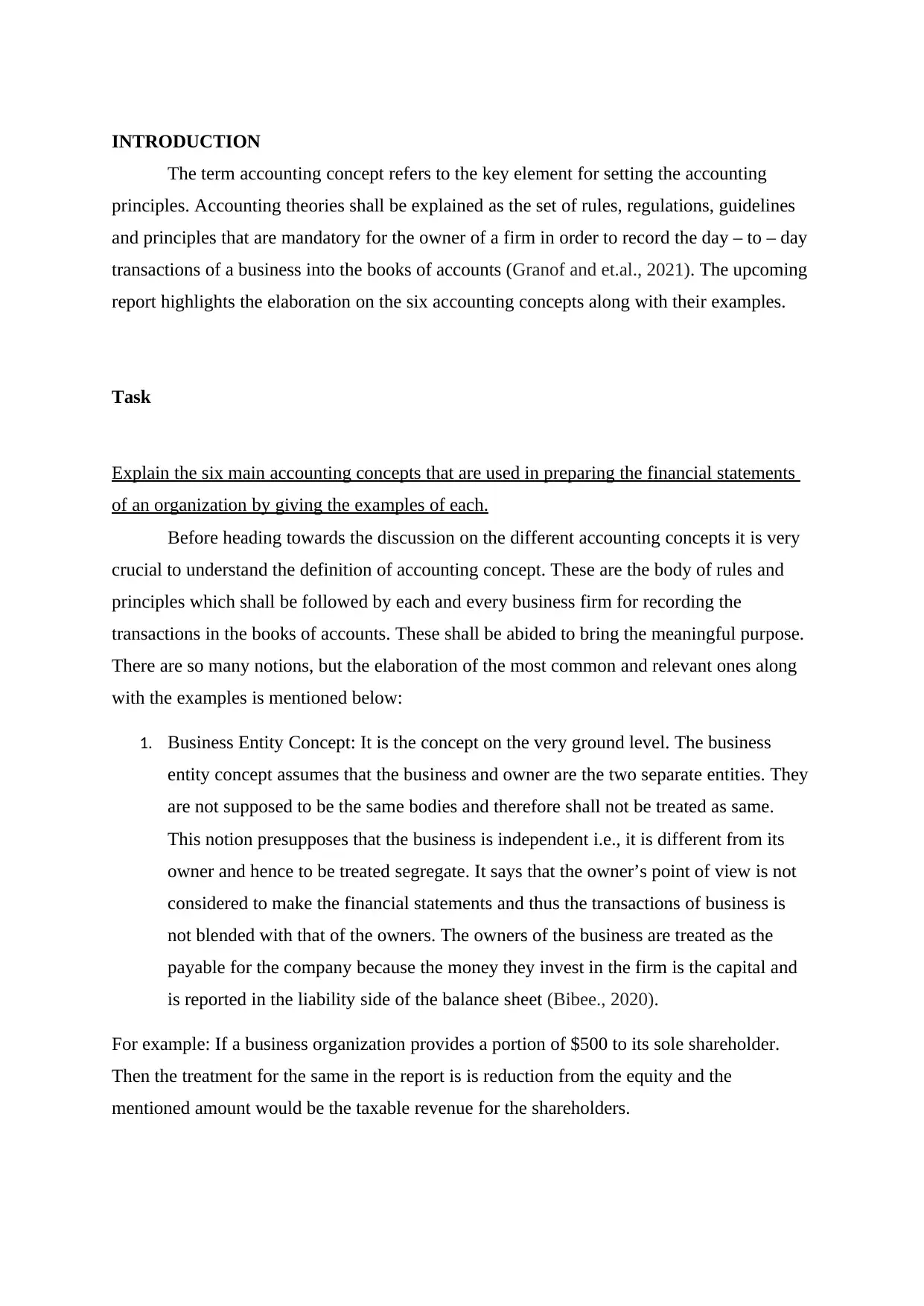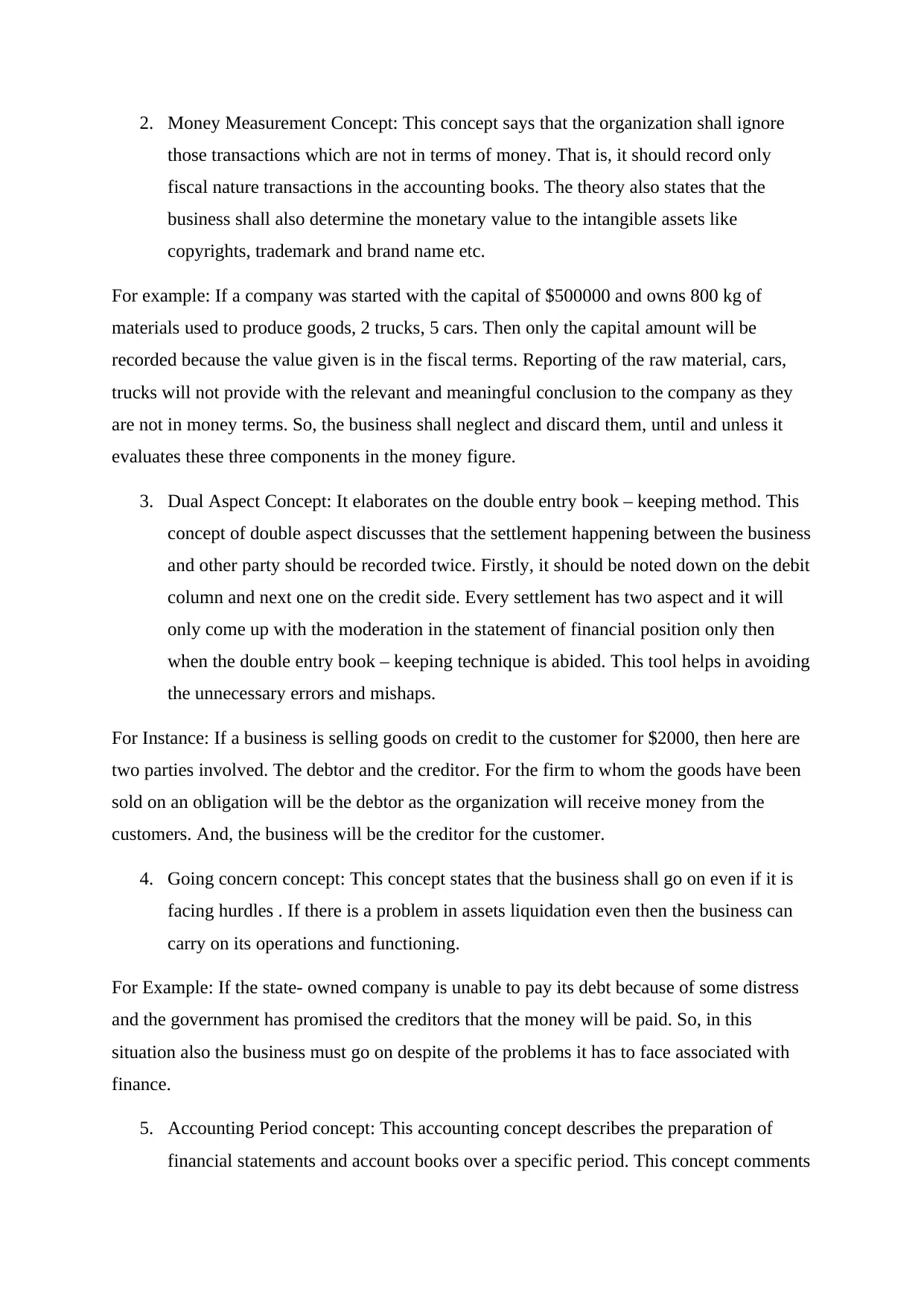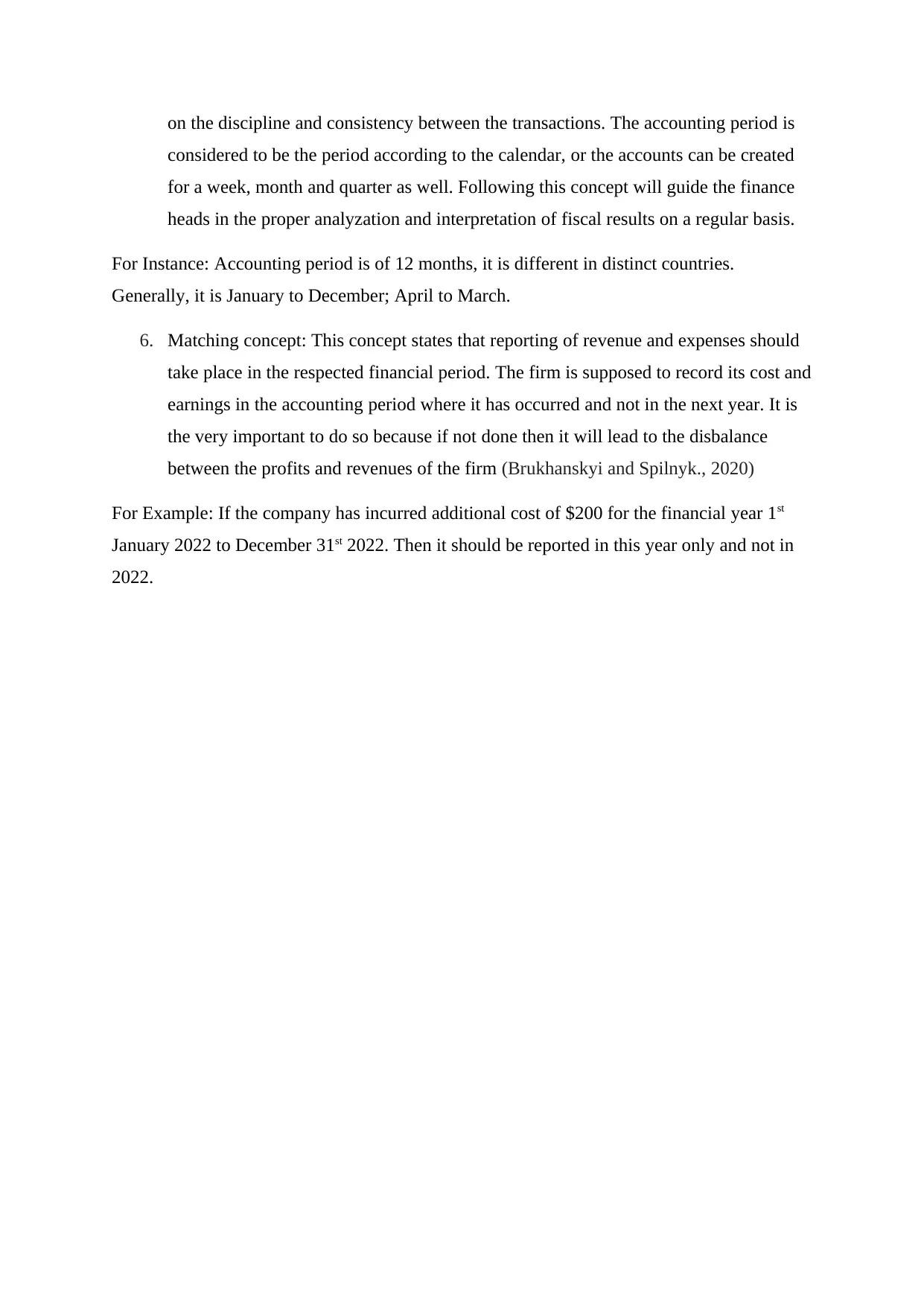Comprehensive Report on Key Accounting Concepts with Examples
VerifiedAdded on 2023/06/10
|7
|1261
|333
Report
AI Summary
This report provides a detailed overview of six fundamental accounting concepts essential for preparing financial statements. It begins by defining accounting concepts and their importance in setting accounting principles. The report then elaborates on the business entity concept, emphasizing the separation of business and owner. It explains the money measurement concept, focusing on the recording of monetary transactions. The dual aspect concept, illustrating the double-entry bookkeeping method, is also discussed. Furthermore, the report covers the going concern concept, which assumes business continuity, and the accounting period concept, highlighting the preparation of financial statements over specific periods. Lastly, the matching concept is explained, emphasizing the importance of reporting revenues and expenses in the correct financial period. Each concept is illustrated with practical examples to enhance understanding. The report concludes by summarizing the importance of adhering to these concepts for maintaining consistency and balance in financial settlements.

Individual Report
Paraphrase This Document
Need a fresh take? Get an instant paraphrase of this document with our AI Paraphraser

Contents
INTRODUCTION...............................................................................................................................3
Task......................................................................................................................................................3
Explain the six main accounting concepts that are used in preparing the financial statements of an
organization by giving the examples of each.....................................................................................3
CONCLUSION....................................................................................................................................6
References............................................................................................................................................7
INTRODUCTION...............................................................................................................................3
Task......................................................................................................................................................3
Explain the six main accounting concepts that are used in preparing the financial statements of an
organization by giving the examples of each.....................................................................................3
CONCLUSION....................................................................................................................................6
References............................................................................................................................................7

INTRODUCTION
The term accounting concept refers to the key element for setting the accounting
principles. Accounting theories shall be explained as the set of rules, regulations, guidelines
and principles that are mandatory for the owner of a firm in order to record the day – to – day
transactions of a business into the books of accounts (Granof and et.al., 2021). The upcoming
report highlights the elaboration on the six accounting concepts along with their examples.
Task
Explain the six main accounting concepts that are used in preparing the financial statements
of an organization by giving the examples of each.
Before heading towards the discussion on the different accounting concepts it is very
crucial to understand the definition of accounting concept. These are the body of rules and
principles which shall be followed by each and every business firm for recording the
transactions in the books of accounts. These shall be abided to bring the meaningful purpose.
There are so many notions, but the elaboration of the most common and relevant ones along
with the examples is mentioned below:
1. Business Entity Concept: It is the concept on the very ground level. The business
entity concept assumes that the business and owner are the two separate entities. They
are not supposed to be the same bodies and therefore shall not be treated as same.
This notion presupposes that the business is independent i.e., it is different from its
owner and hence to be treated segregate. It says that the owner’s point of view is not
considered to make the financial statements and thus the transactions of business is
not blended with that of the owners. The owners of the business are treated as the
payable for the company because the money they invest in the firm is the capital and
is reported in the liability side of the balance sheet (Bibee., 2020).
For example: If a business organization provides a portion of $500 to its sole shareholder.
Then the treatment for the same in the report is is reduction from the equity and the
mentioned amount would be the taxable revenue for the shareholders.
The term accounting concept refers to the key element for setting the accounting
principles. Accounting theories shall be explained as the set of rules, regulations, guidelines
and principles that are mandatory for the owner of a firm in order to record the day – to – day
transactions of a business into the books of accounts (Granof and et.al., 2021). The upcoming
report highlights the elaboration on the six accounting concepts along with their examples.
Task
Explain the six main accounting concepts that are used in preparing the financial statements
of an organization by giving the examples of each.
Before heading towards the discussion on the different accounting concepts it is very
crucial to understand the definition of accounting concept. These are the body of rules and
principles which shall be followed by each and every business firm for recording the
transactions in the books of accounts. These shall be abided to bring the meaningful purpose.
There are so many notions, but the elaboration of the most common and relevant ones along
with the examples is mentioned below:
1. Business Entity Concept: It is the concept on the very ground level. The business
entity concept assumes that the business and owner are the two separate entities. They
are not supposed to be the same bodies and therefore shall not be treated as same.
This notion presupposes that the business is independent i.e., it is different from its
owner and hence to be treated segregate. It says that the owner’s point of view is not
considered to make the financial statements and thus the transactions of business is
not blended with that of the owners. The owners of the business are treated as the
payable for the company because the money they invest in the firm is the capital and
is reported in the liability side of the balance sheet (Bibee., 2020).
For example: If a business organization provides a portion of $500 to its sole shareholder.
Then the treatment for the same in the report is is reduction from the equity and the
mentioned amount would be the taxable revenue for the shareholders.
⊘ This is a preview!⊘
Do you want full access?
Subscribe today to unlock all pages.

Trusted by 1+ million students worldwide

2. Money Measurement Concept: This concept says that the organization shall ignore
those transactions which are not in terms of money. That is, it should record only
fiscal nature transactions in the accounting books. The theory also states that the
business shall also determine the monetary value to the intangible assets like
copyrights, trademark and brand name etc.
For example: If a company was started with the capital of $500000 and owns 800 kg of
materials used to produce goods, 2 trucks, 5 cars. Then only the capital amount will be
recorded because the value given is in the fiscal terms. Reporting of the raw material, cars,
trucks will not provide with the relevant and meaningful conclusion to the company as they
are not in money terms. So, the business shall neglect and discard them, until and unless it
evaluates these three components in the money figure.
3. Dual Aspect Concept: It elaborates on the double entry book – keeping method. This
concept of double aspect discusses that the settlement happening between the business
and other party should be recorded twice. Firstly, it should be noted down on the debit
column and next one on the credit side. Every settlement has two aspect and it will
only come up with the moderation in the statement of financial position only then
when the double entry book – keeping technique is abided. This tool helps in avoiding
the unnecessary errors and mishaps.
For Instance: If a business is selling goods on credit to the customer for $2000, then here are
two parties involved. The debtor and the creditor. For the firm to whom the goods have been
sold on an obligation will be the debtor as the organization will receive money from the
customers. And, the business will be the creditor for the customer.
4. Going concern concept: This concept states that the business shall go on even if it is
facing hurdles . If there is a problem in assets liquidation even then the business can
carry on its operations and functioning.
For Example: If the state- owned company is unable to pay its debt because of some distress
and the government has promised the creditors that the money will be paid. So, in this
situation also the business must go on despite of the problems it has to face associated with
finance.
5. Accounting Period concept: This accounting concept describes the preparation of
financial statements and account books over a specific period. This concept comments
those transactions which are not in terms of money. That is, it should record only
fiscal nature transactions in the accounting books. The theory also states that the
business shall also determine the monetary value to the intangible assets like
copyrights, trademark and brand name etc.
For example: If a company was started with the capital of $500000 and owns 800 kg of
materials used to produce goods, 2 trucks, 5 cars. Then only the capital amount will be
recorded because the value given is in the fiscal terms. Reporting of the raw material, cars,
trucks will not provide with the relevant and meaningful conclusion to the company as they
are not in money terms. So, the business shall neglect and discard them, until and unless it
evaluates these three components in the money figure.
3. Dual Aspect Concept: It elaborates on the double entry book – keeping method. This
concept of double aspect discusses that the settlement happening between the business
and other party should be recorded twice. Firstly, it should be noted down on the debit
column and next one on the credit side. Every settlement has two aspect and it will
only come up with the moderation in the statement of financial position only then
when the double entry book – keeping technique is abided. This tool helps in avoiding
the unnecessary errors and mishaps.
For Instance: If a business is selling goods on credit to the customer for $2000, then here are
two parties involved. The debtor and the creditor. For the firm to whom the goods have been
sold on an obligation will be the debtor as the organization will receive money from the
customers. And, the business will be the creditor for the customer.
4. Going concern concept: This concept states that the business shall go on even if it is
facing hurdles . If there is a problem in assets liquidation even then the business can
carry on its operations and functioning.
For Example: If the state- owned company is unable to pay its debt because of some distress
and the government has promised the creditors that the money will be paid. So, in this
situation also the business must go on despite of the problems it has to face associated with
finance.
5. Accounting Period concept: This accounting concept describes the preparation of
financial statements and account books over a specific period. This concept comments
Paraphrase This Document
Need a fresh take? Get an instant paraphrase of this document with our AI Paraphraser

on the discipline and consistency between the transactions. The accounting period is
considered to be the period according to the calendar, or the accounts can be created
for a week, month and quarter as well. Following this concept will guide the finance
heads in the proper analyzation and interpretation of fiscal results on a regular basis.
For Instance: Accounting period is of 12 months, it is different in distinct countries.
Generally, it is January to December; April to March.
6. Matching concept: This concept states that reporting of revenue and expenses should
take place in the respected financial period. The firm is supposed to record its cost and
earnings in the accounting period where it has occurred and not in the next year. It is
the very important to do so because if not done then it will lead to the disbalance
between the profits and revenues of the firm (Brukhanskyi and Spilnyk., 2020)
For Example: If the company has incurred additional cost of $200 for the financial year 1st
January 2022 to December 31st 2022. Then it should be reported in this year only and not in
2022.
considered to be the period according to the calendar, or the accounts can be created
for a week, month and quarter as well. Following this concept will guide the finance
heads in the proper analyzation and interpretation of fiscal results on a regular basis.
For Instance: Accounting period is of 12 months, it is different in distinct countries.
Generally, it is January to December; April to March.
6. Matching concept: This concept states that reporting of revenue and expenses should
take place in the respected financial period. The firm is supposed to record its cost and
earnings in the accounting period where it has occurred and not in the next year. It is
the very important to do so because if not done then it will lead to the disbalance
between the profits and revenues of the firm (Brukhanskyi and Spilnyk., 2020)
For Example: If the company has incurred additional cost of $200 for the financial year 1st
January 2022 to December 31st 2022. Then it should be reported in this year only and not in
2022.

CONCLUSION
The above report gives the clear representation on the goals of accounting concepts. It
can be concluded that the business firm shall follow these concepts to maintain consistency
and balance between the settlements.
The above report gives the clear representation on the goals of accounting concepts. It
can be concluded that the business firm shall follow these concepts to maintain consistency
and balance between the settlements.
⊘ This is a preview!⊘
Do you want full access?
Subscribe today to unlock all pages.

Trusted by 1+ million students worldwide

References
Books and Journals
Granof, M.H., Khumawala, S.B. and Calabrese, T.D., 2021. Government and not-for-profit
accounting: Concepts and practices. John Wiley & Sons.
Bibee, A., 2020. Sharpest Tool in the Shed-Accounting Concepts for Managing the Collections
Budget. Serials Review. 46(1). pp.69-72.
Brukhanskyi, R. and Spilnyk, I., 2020. Digital accounting: concepts, origins and current discourse.
(3-4). pp.7-20.
Wang, G., 2021, September. Establishment of Fusion Model of Financial Accounting and
Management Accounting Based on Cloud Computing Technology. In 2021 4th
International Conference on Information Systems and Computer Aided
Education (pp. 428-432).
Books and Journals
Granof, M.H., Khumawala, S.B. and Calabrese, T.D., 2021. Government and not-for-profit
accounting: Concepts and practices. John Wiley & Sons.
Bibee, A., 2020. Sharpest Tool in the Shed-Accounting Concepts for Managing the Collections
Budget. Serials Review. 46(1). pp.69-72.
Brukhanskyi, R. and Spilnyk, I., 2020. Digital accounting: concepts, origins and current discourse.
(3-4). pp.7-20.
Wang, G., 2021, September. Establishment of Fusion Model of Financial Accounting and
Management Accounting Based on Cloud Computing Technology. In 2021 4th
International Conference on Information Systems and Computer Aided
Education (pp. 428-432).
1 out of 7
Related Documents
Your All-in-One AI-Powered Toolkit for Academic Success.
+13062052269
info@desklib.com
Available 24*7 on WhatsApp / Email
![[object Object]](/_next/static/media/star-bottom.7253800d.svg)
Unlock your academic potential
Copyright © 2020–2025 A2Z Services. All Rights Reserved. Developed and managed by ZUCOL.



